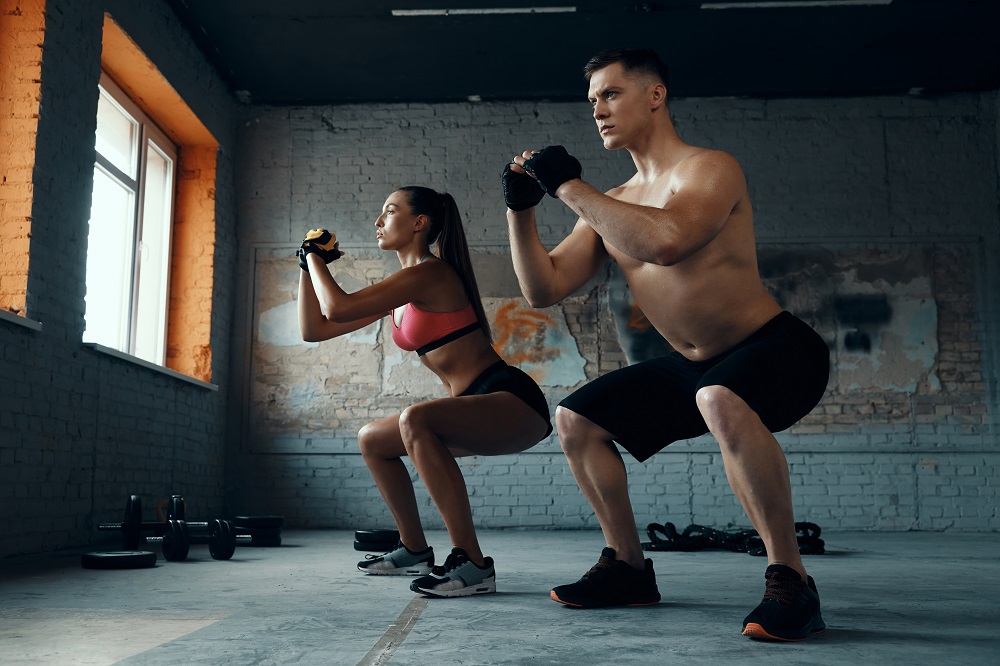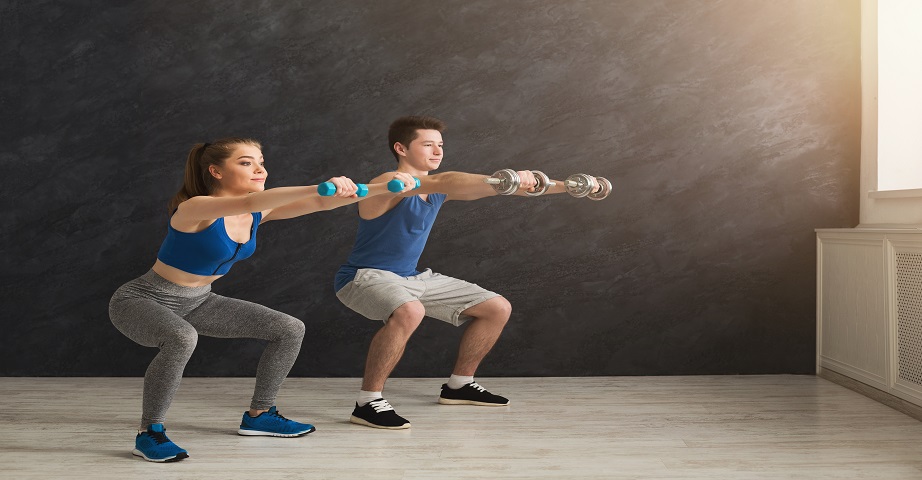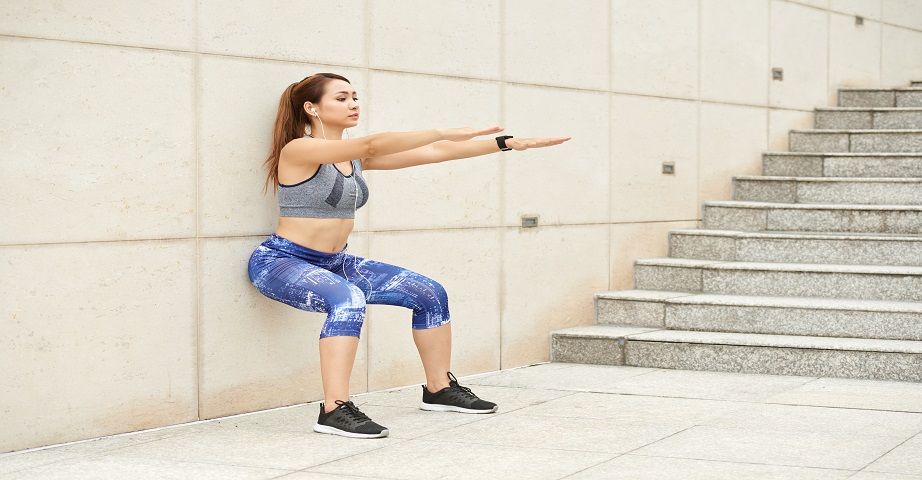Squats - a popular exercise for the lower parts of the body. How to do squats and what do they give?

Squats are one of the most popular multi-joint exercises that come in different variants. They help build strong and muscular legs, but also shapely buttocks or slender thighs. These are some of the most effective exercises that are invaluable when shaping the lower body parts. What are they and how to do squats correctly? What are the types of squats, and what effects can be expected after their regular practice? How to do squats with a barbell?
Summary
What are squats?
Squats are a type of physical activity that is sometimes referred to as the exercise king. This is a popular multi-joint exercise that can be found in almost every training plan. They are not complicated and are distinguished by high efficiency. The squats are exercises that involve bending the hips and bending the knees, while maintaining the natural curves of the spine and straight back.
The proper squats engage many different muscles, effectively strengthening the lower body parts and core muscles. In the classic squat, the weight of your own body is used, while there are also numerous modifications of the exercise, during which additional loads are also used, for example in the form of a barbell.
Squat - what muscles work during the exercise?
The squats are, as we have already mentioned, multi-joint exercises. This means that they engage many different muscles to work. Mostly, when performing the squat work the quadriceps femoris muscles, as well as the gluteus muscles, especially the gluteus maximus muscle, and the adductors of the thighs.
During the squat, when "going down", hip flexors and gastrocnemius are also strongly involved. The muscles around the knee, as well as the deep muscles that stabilize the spine and core muscles, such as the abdominal muscles, the erector spinae, the pelvic floor muscles and the diaphragm, also do their work.
In the case of the squats with a load, to work may be also involved muscles, such as:
- back muscles,
- dorsal muscles,
- biceps,
- triceps,
- forearms.
How to do squats? - 9 steps to do the right squats
Before we dispel the mystery of the correct technique of squats, we will mention the warm-up, which is a key element of all physical activities. Exercises that are worth doing during the warm-up before the start of squats are, for example:
- run in place,
- jumping rope,
- jumping jack,
- hip twists,
- knee circling,
- riding a stationary bike.
After discussing the warm-up, we can go to the specifics, that is, the answer to the question of what is the correct squat technique. The right position is extremely important because it is responsible for the effectiveness of the exercises and reduces the risk of injury. Therefore:
- Stand in a small straddle - set your feet to the width of your shoulders and toes to spacing outwards. Transfer all body weight to the surface of the feet.
- Pucker your shoulder blades and open your chest. Keep your upper body in a straight line and do not round your shoulders or back.
- On the exhale, pull in your stomach as if you want to bring your navel closer to your back and keep your abdominal muscles tight.
- Pull your arms out in front of you.
- Breathe in and start moving - push your hips back and bend your knees. Focus on making your knees point towards the big toe of your foot. Don't take your knees inside.
- The depth of the squat should be comfortable for you. Keep the natural curvature of the spine and try to lower the hips below the knee line.
- At the underside of the squat stay for about 1 second.
- With the exhalation, return smoothly to the starting position, while activating the buttock muscles and the front part of the thigh.
- Control your movements and do another repetition.
Also remember that it is better to perform one correct squat than five incorrect exercises. Therefore, mastering the correct technique, do not rush. Focus on your movements and control them.
Until recently (perhaps you remember it from school days...) the squats during which the knee was behind the finger line, were considered a mistake. At that time, it was considered that half-squats are safer because they do not burden the knees. However, current research suggests that half squat is only half the success, because a larger range of movements can have a positive effect on the knees, as well as on the involvement of a larger group of muscles.
To this day there are errors that, unfortunately, are often duplicated and can negatively affect both the knees and the back, or the entire musculoskeletal system. How should squats not be performed?

The most common mistakes when doing squats
Although the squats seems simple, in practice it requires proper preparation and development of the right technique. What mistakes happen the most often when exercising?
- No warm-up,
- rounding the back,
- suspending the breath,
- directing the knees inside,
- taking heels off the floor,
- pushing the hips forward or a hyperextension in the knees when standing up,
- loss of neutral position of the spine,
- when performing squats with additional equipment, reaching for excessive load or performing exercises without belaying.
Squats - effects. What do squats give?
The squats are an effective exercise that can not only help you achieve your dream figure, but also get a free ticket for public transport. It is true that you can gain a free ride only in Romania, when you do 20 squats in two minutes, but the proposal still sounds tempting.
Among the advantages of the squats, it is worth paying attention to the fact that the effort can be performed anywhere, without specialized equipment. The classic squats can be done at home, in the gym, as well as in the garden. It is also worth noting that the squats can have a beneficial effect on the human body by shaping the lower parts of the body and strengthening them. The exercise can also help slim your thighs and sculpt your legs, as well as firm your buttocks and reduce cellulite. During the regular squats, you can see an improvement in blood circulation. The physical activity can also support the proper functioning of the endocrine system, and the squats performed with a load can promote an increase in bone mineral density.
An undoubted advantage of the squats is also the fact that the exercise can increase the rate of fat burning and help reduce body weight. They can also increase mobility, especially in the hip, knee and ankle areas, as well as muscle condition and strength. The squats can also have a positive effect on ability to maintain balance. The regular squats can have a positive effect on the flexibility of muscles, joints and tendons, and support the maintenance of normal body posture.
The properly performed squats can reduce the risk of knee injury and injury during daily activities. The exercise can also improve the comfort of everyday life and make it easier to perform common activities, such as getting up from a chair or sitting down.
Squats - when are the effects?
You already know what the proper squat looks like and what the positive results of regular practice of this type of exercise can be. So the question remains, when can the first effects be expected?
Much depends on the technique of squats, their type and the load used, as well as on individual conditions and lifestyle and diet, but in general it can be said, that the first effects of the regularly performed squats should be visible after a month of the exercises.
How many squats should do?
It is difficult to answer the question about the recommended number of squats during training. This is an individual matter, which depends, among others, on the level of training, the frequency of training or the nature of the training plan.
It is important to do the exercise regularly and correctly. It is also important that beginners perform the squats using their own body weight, and only with the increase in the level of advancement, they used from additional loads during training.
Remember that even a small amount of the squats performed regularly can be associated with achieving positive results!

Types of squats
One of the many advantages of the squats is their diversity, which makes the exercise can be adapted to individual preferences and possibilities, as well as to your training plan, modifying only the type of squat. The specific version of the exercise can also be selected based on training goals, taking account of injuries.
The squats can be divided into those performed using the weight of your own body, and those that require additional load. Among the squats without load can be distinguished, for example:
- Classic squats - the most popular version of the squat. You need to stand in a straddle and rest the weight of the whole body on the surface of the feet. Then inhale, move the pelvis and hips back and down, and then bend the knees and do the squat. It is worth making sure that the axis of the knees, ankles and big toes is in one line, and the back retains the natural curvature of the spine. During a smooth return to the starting position, you should exhale and focus on the muscles of the buttocks and the front of the thighs.
- Squats with a jump - the beginning of the squat looks similar to the classic version of the exercise. However, the return to the starting position should be faster, with a jump element. This is a great exercise during intervals or cardio training, which can additionally boost the metabolism.
- Bulgarian squats - this is an ideal exercise for stabilizing and strengthening the buttock muscles. It involves doing the squat on one leg, while the other is leaning on the back for a raise, such as a chest or chair.
- Wall sit - it involves taking a position similar to sitting on a chair, but without a chair. It is necessary to lean against the wall and go down to the squat, in such a way that the thighs are laid parallel to the floor or slightly lower.
- Squats on one leg - stand in front of a bench or chest and while going down to the squat, transfer the weight of the body to one leg, and lift the other up, while touching the buttocks of the equipment placed behind you.
- Sumo squats - this is an exercise performed in a wide straddle, in which the feet must be set wider than the shoulders, and when going down, the knees should be directed over the ankles.
On the other hand, the squats with load are popular exercises that require additional equipment. The most frequently performed activities of this type can include, among others.:
- Squats with a barbell on the neck - place the barbell on the stand at the height of the clavicles, and then stand under it with legs part over the width of the shoulders. The barbell should be placed behind the neck and caught with both hands with elbows pointing down at the same time. Next, remove the barbell from the stand, take a step back and perform a squat, and after the series - put the barbell to the right place.
- Front squats - squats with a barbell on the shoulders - a technique similar to the squat with a barbell on the back, but the equipment should be placed in front of you and sit-ups performed with a barbell held in front, on the shoulders. Then it is important that the elbows are directed upwards.
- Sumo squats with dumbbells - the squat with a dumbbell - when performing the sumo squat, you should hold a dumbbell and lift it with arms stretched parallel along the body.
- Bulgarian squat with kettles - a typical Bulgarian squat, during which you should keep a kettle along the body.
- Squats with resistance band- a resistance band should be set above the knees, which during exercise is an additional resistance that can positively affect the effectiveness of the activity performed. The squats with resistance band is often used form of rehabilitation, for example, after injuries of the cruciate ligaments.

